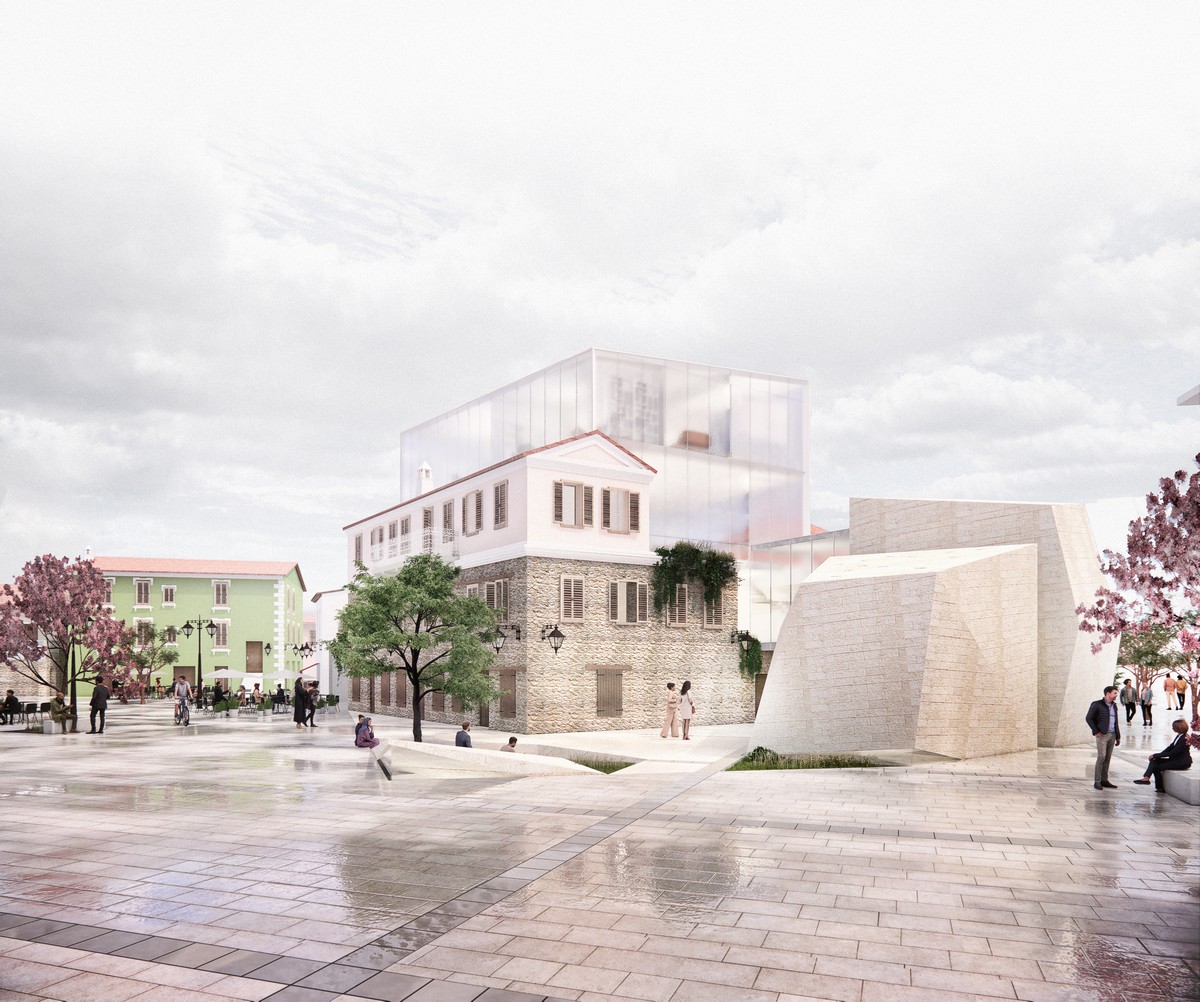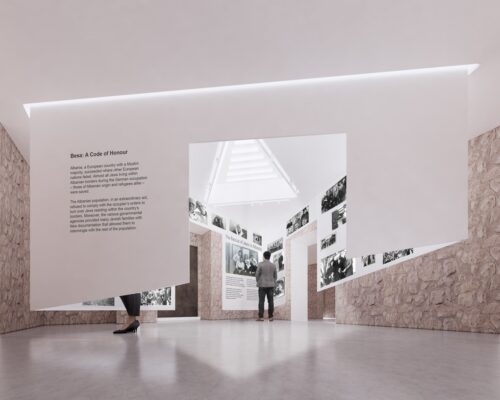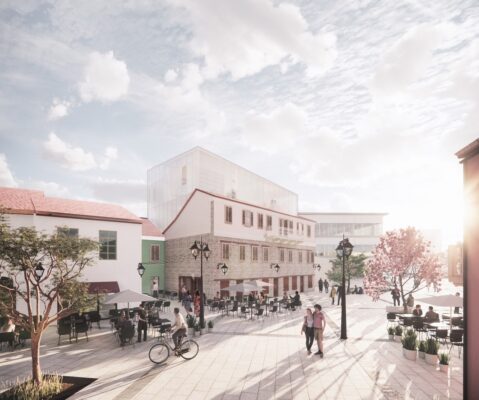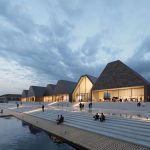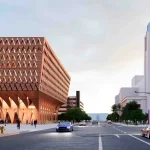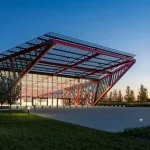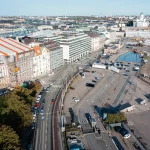Albania Jewish Museum Vlorë building project, Albanian architecture by Israeli Architects, Design images
Albania Jewish Museum Vlorë
26 Aug 2022
Design: Kimmel Eshkolot Architects
Location: city of Vlorë, Albania
Albania Jewish Museum by Kimmel Eshkolot
Kimmel Eshkolot Tapped As Lead Architect For The Albania Jewish Museum In The City Of Vlorë
The Construction of the Innovative Cultural Space and Development Will Begin in Q4 2022, is Scheduled for Delivery in 2025
Tel Aviv, Israel – August, 2022: Award-winning Israeli architecture firm Kimmel Eshkolot today officially announces its being commissioned as the lead architect for the forthcoming Albania Jewish Museum, in Vlorë, a prestigious museum symbolizing the history of the Jewish community of Albania. Kimmel Eshkolot was the only Israeli architecture firm to be invited to propose for the museum, which will officially open in 2025.
Evening view of the Albanian Jewish Museum:
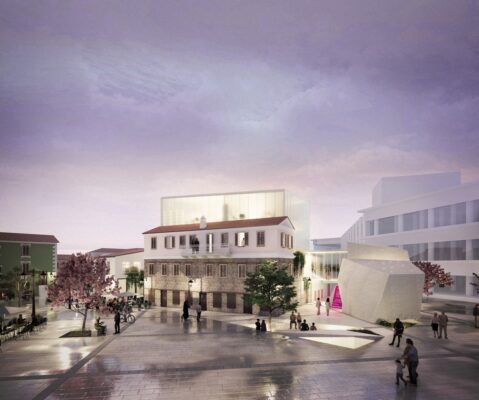
The museum embodies the future of sustainability in architecture and design by preserving large parts of a historical building, paying homage to the past, present and future of the Albanian Jewish community, while using innovative glass panels for the new facades. In keeping with its sustainable approach to architecture, Kimmel Eshkolot will make the most use of the existing structure, utilizing the thermal qualities of the original thick stone walls. Most of the new stone construction will be with a local stone from Albania, apart from an outdoor area which will be clad in Jerusalem stone from Israel.
Nested within the old city of Vlorë, the third largest city in Albania which sprawls on the Bay of Vlorë and is surrounded by the foothills of the Ceraunian Mountains along the Adriatic coast, the Albania Jewish Museum will exist as a cultural hub embedded within the context of a historical building around which it is designed. The museum will trace the history of the Albanian Jewish community from the early Roman era up until today, while emphasizing the unique story of Jews in Albania during World War II. The museum will activate its urban environment and contribute to the city’s civic development through the creation of several unique spaces, ranging from flexible exhibition rooms to public areas.
The museum’s entrance pavilion extending the museum to the public square:
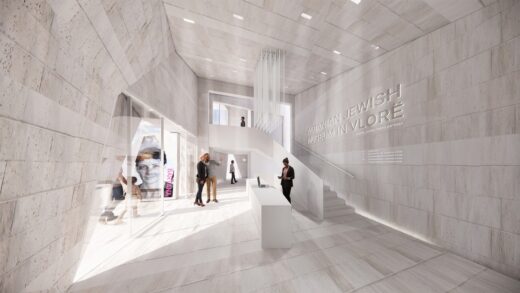
The innovative museum is based around three key elements, including a meticulously preserved historic house with a contemporary addition; a connecting pavilion; and an open-air room. Each of the structures are carefully positioned to enable pedestrian routes from Perlat Rexhepi Street and Ceno Sharra Street. With the new outdoor spaces, the museum will rejuvenate the square and extend itself to the city of Vlorë.
The open-air room is carved into the square, creating new seating areas that will serve both visitors of the museum and the general public. The volume of the entrance pavilion is cut to create an appealing alleyway on the east side towards the historical building, revealing a portion of the museum content which is exhibited on an open-faced stone door. The open-air room is an inviting public space offering power outlets for phones, Wi-Fi and a drinking fountain in addition to seating and shading from a newly planted olive tree. The material finish of the entrance pavilion will be made out of unique Jerusalem limestone from Israel.
The WWII room in the preserved historical building
In between the preserved building is a connecting pavilion and open-air room, entitled the “Besa Space.” The intimate and inclusive place is an expression of Besa, the Albanian code of honor, anchored on values of solidarity, ethical commitment to others and hospitality. The Besa Space embodies key values of the museum based upon the engagement of city residents as well as international visitors. This space will also be paved in a different stone than that of the existing square to draw an aesthetic connection to the museum itself.
There are three exterior additions to the historical building, including an entrance pavilion, a small but iconic structure with a unique interior space that is cladded in stone with small slits on the roof as skylights; additional volume on top of the historical house that is designed as a transparent and neutral volume to pay respect to the existing building; and an underground addition designed to house the space for temporary exhibitions and have a minimal impact on the square above. The underground excavation will be limited to the space below the square and the courtyard of the historical building. The temporary exhibition space is the only part of the museum with extended floor to ceiling height (approximately 4.5-square-meters or 14-square-feet).
Etan Kimmel, lead architect and firm principal, says: “We are honored to be entrusted by the city of Vlorë and Albanian Jewish community to spearhead the design of what will be an important institution not only for Albanians, but for the world. The museum will tell the story of the Albanians’ saving of the Jews during WWII whilst creating a physical experience elevated by our meticulous approach to emotion-evoking architecture and design.”
View of the temporary exhibitions space:
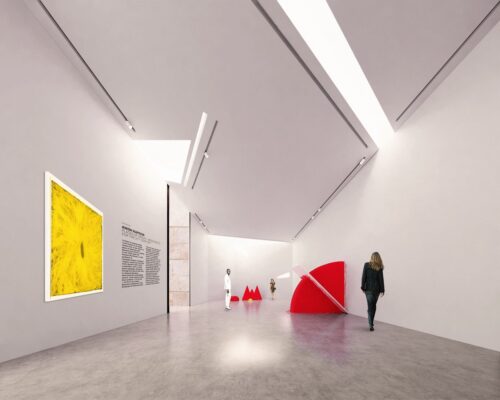
Material related to the period of World War II in Albania will be exhibited in the north-west room of the ground floor and serve as the climax of the permanent exhibition. A deconstructed star of David will be perceived by two intersecting triangles: one projected from the ceiling and one as a physical triangular exhibition wall configuration. The temporary exhibitions will be accessed through the pavilion that also communicates the temporary show through a LED screen on its always open stone door. From this exhibition space, visitors can either exit through the pavilion or go up to access the historical building through the bridge.
The new volume on top of the historical building is designed with a lightweight roof to avoid applying extensive weight and in order to use a simple structural system. Excavation efforts to the basement level is limited solely to underneath the courtyard and the square, thus avoiding extensive costs. The design achieves an extremely efficient net to gross floor area ratio with minimal service areas.
The exhibition spaces are designed to create large and flexible areas where many layouts can be tested with time. Only the north-west room on the ground floor has a permanent installation, with a small triangle protruding to the room above. The rooms of the permanent exhibition are able to be dimmed for video projections and screens, as they only have the original openings of the historical building. The temporary exhibition space has a technical ceiling with acoustic panels and tracks for spotlights and mounting. Skylights in this space are concentrated on the north side, so its south side can be more dimly lit.
For more information about Kimmel Eshkolot, visit https://www.kimmel.co.il/.
Kimmel Eshkolot Architects
Kimmel Eshkolot Architects is an award-winning architecture studio, founded by Etan Kimmel and Michal Kimmel Eshkolot in 1986 in Tel Aviv. The practice of the studio spans across scales with a focus on cultural and civic projects, as well as urban design, residential and interior design.
In their first years of practice, Kimmel Eshkolot Architects were involved in the preservation and rehabilitation of Tel Aviv’s historical Neve Tzedek neighborhood, for which they were awarded the Rokach Prize for Architecture in 1993. Throughout the years they have won several national competitions for the design of high-profile public projects, such as the new expansion of the Kiryat Hamemshala government compound in Jerusalem, the Davidson Museum in the Archaeological Park near the Western Wall and the Memorial Hall for Israel’s Fallen on Mount Herzl. In 2011, they won the Rechter Prize for Architecture, considered to be the most prestigious award for architecture in Israel.
They received the award for the design of a rehabilitation center in Beer Sheva, in the south of Israel. This project was also selected for project of the year in the international competition of the magazine Israeli Architecture.
In 2018, Kimmel Eshkolot Architects won the International Award for Excellence for The Memorial Hall on Mount Herzl from the Royal Institute of British Architects (RIBA) and joined RIBA’s list of 20 best new buildings in 2018. Comprised of 30 architects, the studio is currently involved in dozens of projects, both in Israel and in Europe, and recently they won an international competition to design the Albanian Jewish Museum, in Vlorë, Albania.
Albania Jewish Museum Vlorë Building images / information received 250822 from Kimmel Eshkolot Architects
Location: Tirana, Albania, southeastern Europe
Albania Architecture
Albanian Architecture – Selection
Architects: MVRDV
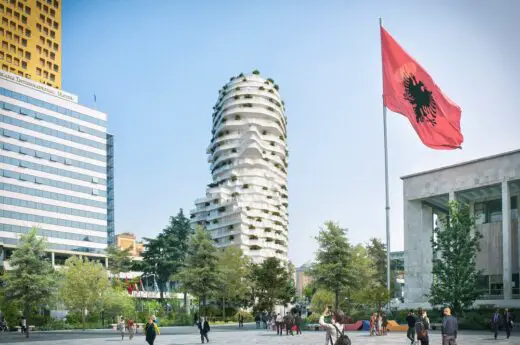
image © MVRDV
Skanderbeg Building Tirana
Architects: MVRDV
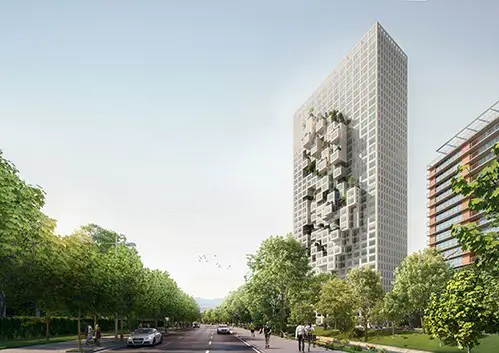
image © MVRDV
One Tower in Tirana
Skanderberg Square Renewal, Tirana
Design: 51N4E architects
Tirana Square Design
Tirana Lakeside – Competition
Design: MVRDV
Tirana Lake Architecture Competition : Winner
Xezhmy Delli str. Apartments, Tirana
Architect : baukuh
Albanian Residential Building
Southeastern Europe Architecture
Developments in Countries nearby:
Albanian Architecture Competition Design
Comments / photos for the Albania Jewish Museum Vlorë Building design by Kimmel Eshkolot Architects page welcome

